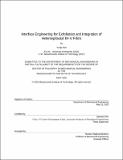Interface engineering for exfoliation and integration of heteroepitaxial III-V films
Author(s)
Kim, Yunjo.
Download1191716059-MIT.pdf (2.705Mb)
Other Contributors
Massachusetts Institute of Technology. Department of Mechanical Engineering.
Advisor
Jeehwan Kim.
Terms of use
Metadata
Show full item recordAbstract
Compound semiconductors composed of III-V alloys play an essential role in modern optoelectronics and high frequency communication due to their superior optical properties and electron mobilities compared to silicon. However, the use of compound semiconductors devices has not seen the same level of wide-spread use compared to silicon owed in part to the significant cost of substrates required for processing III-V devices. To encourage the adoption of III-V technology, many strategies have been proposed to enable monolithic integration of III-V devices on Si to be compatible with Si CMOS technology. One approach to alleviate the cost of integrated III-V devices is to design a process that can selectively release the III-V device layer from its substrate for later heterointegration onto Si, while preserving the substrate for continuous reuse. In this work, we introduce two novel processes for the exfoliation of III-V devices that also enable the reuse of the substrate for continuous processing. We first investigate a novel epitaxial process, termed 'remote epitaxy', that utilize graphene as a platform for epitaxial growth while also enabling the release of III-V devices. In our work, we have found that monolayer graphene interfaced on III-V substrate mildly screens the atomic interaction between the substrate and epitaxial film, enabling epitaxial films to grow with atomic registry to the parent substrate 'remotely' from the surface of graphene. In addition, remote epitaxially grown films could be readily released from the graphene interlayer by application of mechanical stress on the film, preserving the integrity of the substrate and device layer. The process of remote epitaxy and exfoliation of epitaxial films was demonstrated for a range of III-V compound semiconductors, GaAs, InP and GaP. Secondly, we investigate an alternative strategy for thin-film exfoliation and wafer reuse based on a previously established controlled spalling process. In controlled spalling, mechanical stress is imparted onto a substrate by deposition of a stressed metal film in order to induce fracturing of the substrate at a specified depth from the surface. Using this process, the device layer can be released from the substrate at the sacrifice of damaging the substrate. In this work, we propose a non-destructive controlled spalling process that utilizes a mechanical sacrificial buffer layer between the substrate and device layer where selective fracturing can take place. Subsequent to exfoliation, the damaged buffer layer can be selectively etched to recover the original substrate for reuse. This process, termed cleavage plane assisted exfoliation (CPEx), was applied to a GaAs/Ge/GaAs system utilizing Ge epitaxial film as the mechanical sacrificial buffer for the exfoliation of GaAs epitaxial films and reclamation of the original GaAs substrate.
Description
Thesis: Ph. D., Massachusetts Institute of Technology, Department of Mechanical Engineering, May, 2020 Cataloged from the official PDF of thesis. Includes bibliographical references (pages 78-82).
Date issued
2020Department
Massachusetts Institute of Technology. Department of Mechanical EngineeringPublisher
Massachusetts Institute of Technology
Keywords
Mechanical Engineering.